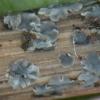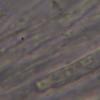
04-09-2009 22:52
Marja PennanenFruitbodies 0,1 to 0, 3 mm wide. Spores 9-2 x 2-3

04-09-2009 18:46
Bonjour à tous, Mercredi dernier, j'ai trouvé

04-09-2009 07:51
 Nicolas VAN VOOREN
Nicolas VAN VOOREN
Bonjour. Voici une récolte que je trouve ambigu�

01-09-2009 00:08
 Yannick Mourgues
Yannick Mourgues
Re bonsoir. Voici encore un autre Hymenoscyphus
Mollisia coerulans?
Luc Bailly,
05-09-2009 16:52
Dochamps, Manhay, Ardenne belge, sur tiges mortes de Eupatorium cannabinum, en situation de clairière forestière, 02.09.09.
Apothécies atteignant 2 mm, gris-bleu, plus pâle à la marge; surface externe brun foncé à la base, marge concolore à l'hyménium.
Asques minces, vite collapsées quand les spores sont éjectées, -> 7 µ d'épaisseur, IKI bleu. Spores (9.5)-11-17 x 2-2.5 µ, non septées, huile = 2-3.
Paraphyses: elles me semblent rares s'il s'agit de corps incrustés env. 4 µ d'épaisseur; ou alors, entre les asques, il y a des des cellules allongées très réfringentes, 3-4 µ d'épaisseur. Aucune réaction notable au KOH.
Excipulum textura globulosa, constitué de cellules brunes -> x 18 µ. Marge sans poils notables.
La clé d'Andreas Gminder ainsi que E&E m'amènent vers Mollisia coerulans Quél.





